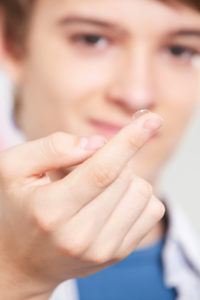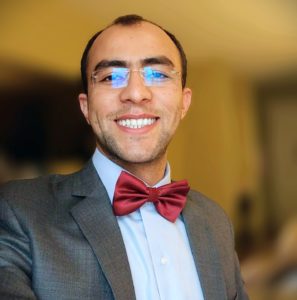July 1, 2022
By Hashim Ali Khan, OD, FAAO, PhD Candidate at Brien Holden Vision Institute

With the recent advancements in myopia control with specialty contact lenses, there is a growing interest among clinicians in fitting children with contact lenses to manage myopia. Since contact lens wear for myopia control is generally long term, there is interest in understanding the impact of long-term contact lens wear on ocular health and safety in children.
In this recently published article, the authors considered the long-term safety and ocular health parameters of 144 children using contact lenses over a six-year period.
In this two-phase research conducted at four sites in four countries, 8- to 12-year-old children wore contact lenses. During the first three years, children were randomly fitted with a dual-focus, center-distance, daily disposable, myopia control lens (MiSight 1 day, CooperVision, Inc.) or a marketed daily disposable lens (Proclear 1 day, CooperVision, Inc.). Both lenses were identical in all aspects except for the dual-focus optics in MiSight lens. Children were evaluated every six months for three years, and during the second phase, all were provided the option to wear MiSight for an additional three years.
Using a uniform grading and reporting protocol, ocular and adverse events (AEs) were reported as Serious, Significant, or Non-significant events. Over the six-year study period, 40 AEs (12 binocular and 28 monocular) occurred in 30 participants, of which 93% were non-significant AEs. There was a single serious adverse event with a participant experiencing a Herpes Zoster-associated uveitis in one eye during year five. The same eye of the participant had previously experienced an event of corneal staining and impaired vision each during years four and five. There were two significant adverse events (new peripheral scars). The crude incidence of infiltrative keratitis was 0.61%. All reported AEs were seen in children who were older than 10 years of age.
During the entire study period, 99% of the participants were found to have Grade 0-1 (none to trace) tarsal hyperemia, tarsal roughness, and bulbar hyperemia on slit lamp biomicroscopy. Ocular health and physiological signs at the end of the study were similar to pre-lens wear.
Overall, these reported data are highly encouraging for successful wear of daily disposable hydrogel contact lenses in children with minimal impact on ocular physiology.
Abstract
Ocular Health of Children Wearing Daily Disposable Contact Lenses Over A 6-Year Period
Jill Woods, Debbie Jones, Lyndon Jones, Susanna Jones, Chris Hunt, Paul Chamberlain, John McNally
Purpose: To report on the ocular health and safety of children fit with soft hydrogel daily-disposable contact lenses, and followed for 6-years in a double-masked clinical trial investigating the performance of a dual-focus contact lens designed to control myopia progression.
Methods: Children aged 8−12 years, naïve to contact lens wear, were enrolled across four international sites. During years 1–3, children were randomised to either MiSight 1 day or Proclear 1 day (both omafilcon A, CooperVision, Inc.). The lenses were identical in material and geometry except for the front optical zone design. At the end of year-3, all those wearing Proclear 1 day were switched to MiSight 1 day, therefore all wore MiSight 1 day in years 4−6. Subjects agreed to wear the lenses at least 10-hours/day, 6-days/week. After dispensing, study visits were at 1-week, 1-month, 6-months and every 6-months until 6-years. At each visit, ocular measurements and subjective responses were recorded. Biomicroscopy used 0–4 grading scales; grade 0 represented no findings.
Results: 144 children were enrolled: 69F:75M; mean age 10.1 years; mean cycloplegic spherical-equivalent refraction -2.11D; ethnicities included 34 East-Asian, 12 West-Asian, and 79 Caucasian. 92 completed the 6-years. Only three subjects discontinued due to an ocular adverse event (AE). No contact lens related AEs were classified as serious. The incidence rate of infiltrative AEs was 0.61% (6.1/1000 wearing-years; 95%CI: 0.24%–1.57%). The most common biomicroscopy findings were limbal, bulbar and tarsal hyperaemia and tarsal roughness. 99% of all biomicroscopy findings were grade-1 or lower. After 6-years of lens wear, ocular health by biomicroscopy was similar to pre-lens wear.
Conclusions: Across the 6-years, there were no contact lens related serious AEs and biomicroscopy showed no significant changes. Results suggest that children this age can successfully wear daily-disposable hydrogel contact lenses with minimal impact on ocular physiology.
Woods, J., Jones, D., Jones, L., Jones, S., Hunt, C., Chamberlain, P., & McNally, J. (2021). Ocular health of children wearing daily disposable contact lenses over a 6-year period. Contact Lens and Anterior Eye, 44(4), 101391.
DOI: 10.1016/j.clae.2020.11.011
 |
Hashim Ali Khan, OD, FAAO, is a current PhD student working on predictive models for myopia progression with Professor Padmaja Sankaridurg at the Brien Holden Vision Institute, University of New South Wales, Sydney. |













